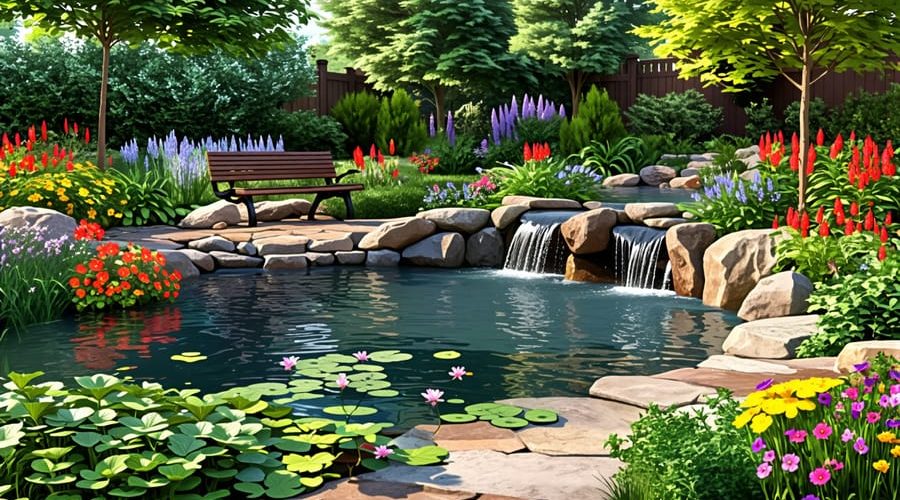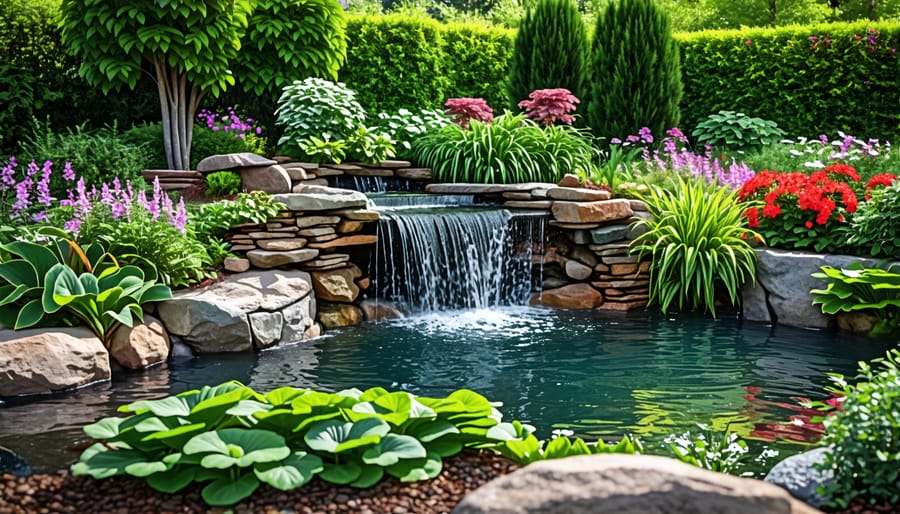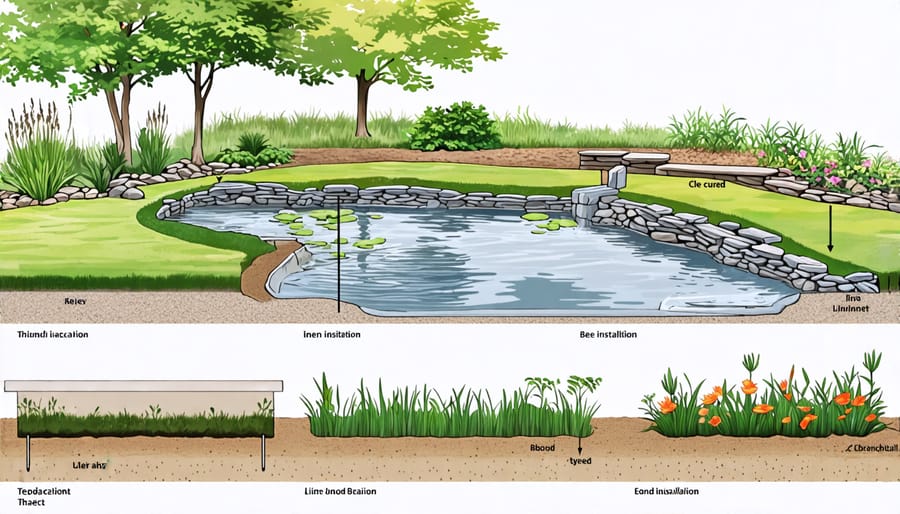
Create a Backyard Oasis: The Ultimate Wildlife Pond Guide
Plan your pond carefully, choosing a location with partial shade and avoiding trees that shed lots of leaves. Dig the pond in tiers or shelves of varying depths to accommodate different aquatic plants and provide diverse habitats. Use a pond liner made of durable, flexible material like EPDM rubber to create a watertight seal. Incorporate natural elements like rocks, logs and marginal plants to create a balanced ecosystem that attracts wildlife and blends seamlessly into your landscape.
Planning Your Wildlife Pond
Choosing the Right Location
When choosing the perfect spot for your backyard wildlife pond, consider key factors like sunlight, terrain, and accessibility. Ideally, select a location that receives at least 6 hours of direct sunlight daily to support aquatic plants and keep the water warm. However, some shade is beneficial to prevent excessive algae growth. Assess the terrain and choose a level area or one that can be easily excavated and leveled. Avoid low-lying spots prone to flooding or areas with underground utilities. Think about accessibility both during construction and for future maintenance. You’ll want to be able to reach the pond easily for cleaning, repairs, and enjoying the space. Consider the view from your home or patio and choose a location that complements your landscape design. Keep the pond away from trees to minimize leaf litter and debris accumulation. By carefully evaluating these factors, you’ll be well on your way to creating a thriving and enjoyable backyard oasis.
Determining the Size and Depth
When determining the size and depth of your backyard wildlife pond, consider the available space and your goals for the pond. A larger pond offers more room for aquatic life and plants, while a smaller pond is easier to maintain. As a general rule, aim for a minimum surface area of 50 square feet and a depth of at least 2 feet in the deepest part. This depth allows aquatic creatures to overwinter safely in colder climates.
If you want to attract a diverse range of wildlife, consider creating different depth zones within your pond. Shallow areas around 6 inches deep provide a perfect spot for marginal plants and a place for birds and insects to drink and bathe. Deeper areas, around 18-24 inches, offer space for floating plants and fish to thrive. Ultimately, the size and depth of your pond should fit your yard and your vision for the space.
Sketching Out the Design
Sketching out your backyard wildlife pond design is an exciting step in the creation process. Start by considering the size and shape that will best fit your space and complement your landscaping. Use a garden hose or rope to outline potential pond shapes on the ground, stepping back to visualize how each option would look. Don’t forget to plan for features like waterfalls, streams, or shallow areas for wildlife to access the water. Incorporate surrounding plantings and rock formations into your sketch to create a cohesive design. Remember, a natural-looking pond with gently curving edges often blends best with the environment and appeals to wildlife. With a well-planned sketch in hand, you’ll be ready to bring your backyard oasis to life.

Building Your Pond
Excavation and Lining
To begin excavating your backyard wildlife pond, mark out the desired shape and size using spray paint, string, or a garden hose. Start digging with a shovel, gradually deepening the pond to create various levels for plant shelves and wildlife habitats. Aim for a depth of at least 2 feet in the center to ensure the pond won’t completely freeze in winter.
As you dig, remove any rocks, roots, or debris that could puncture the pond liner. Create a gradual slope along the edges to allow animals to easily enter and exit the water. Once the desired shape and depth are achieved, smooth out the pond bottom and sides, removing any sharp objects.
Next, line the excavated pond with a thick, durable pond liner to prevent water loss and protect the pond’s ecosystem. Before installing the liner, add a layer of sand or special pond underlayment to cushion the liner and prevent punctures. Carefully unfold the liner and place it into the pond, ensuring it conforms to the contours without stretching. Secure the edges of the liner with heavy rocks or by burying it in a trench around the pond’s perimeter.
With the liner in place, fill the pond with water, smoothing out any wrinkles as the water level rises. Once filled, trim away any excess liner, leaving enough to securely anchor the edges. Your backyard wildlife pond is now ready for the next steps in creating a thriving aquatic habitat.

Edging and Landscaping
Here are 150 words for the “Edging and Landscaping” section of your backyard wildlife pond article:
To seamlessly integrate your pond into the landscape, focus on naturalizing the edges. Avoid abrupt transitions by gradually sloping the soil up from the water’s edge and planting moisture-loving plants like rushes, sedges, and marginal aquatics. Create a natural look by arranging rocks and boulders along the shoreline, partially submerging some for a realistic effect.
Extend the pond’s ecosystem into the surrounding yard by planting native wildflowers, shrubs, and trees that provide food and shelter for wildlife. Design curving, informal pathways using natural materials like wood chips or stepping stones to invite exploration. Include seating areas with benches or large flat rocks where you can quietly observe the bustling activity in and around your pond.
By softening the edges and creating a diverse, layered landscape around your pond, it will look like a natural part of the environment, enhancing the beauty and biodiversity of your backyard oasis.
Adding Water and Features
After completing the pond construction and ensuring its structural integrity, it’s time to fill it with water. Start by placing a hose in the deepest part of the pond and let the water flow slowly, allowing it to gently fill the basin. As the water level rises, monitor for any leaks or issues with the liner. Once filled, let the pond settle for a few days to allow the water chemistry to stabilize.
To add visual interest and oxygenation, consider incorporating water features like waterfalls or fountains. Waterfalls can be created by strategically placing rocks and boulders to guide the water flow from a higher point into the pond. Use a submersible pump to circulate the water and create the cascading effect. Fountains, on the other hand, can be installed as standalone features or integrated into the pond design. They come in various styles, from simple spouts to intricate spray patterns, adding both aesthetic appeal and gentle water movement.
When selecting water features, consider their size in relation to your pond’s dimensions and the desired effect. Ensure that the pump’s flow rate matches the feature’s requirements for optimal performance. Position the features in a way that enhances the pond’s overall appearance and creates a harmonious balance with the surrounding landscape. With the addition of water and carefully chosen features, your backyard wildlife pond will come to life, creating a captivating and tranquil oasis.
Stocking Your Wildlife Pond
Choosing Aquatic Plants
When selecting aquatic plants for your backyard wildlife pond, consider their roles in oxygenation, habitat creation, filtration, and aesthetics. Submerged plants like hornwort and anacharis are excellent oxygenators that help maintain water quality. Floating plants such as water lettuce and water hyacinth provide shade and shelter for pond inhabitants while also absorbing excess nutrients. Marginal plants like cattails and rushes offer valuable habitat for wildlife and aid in natural filtration. For a visually appealing pond, incorporate a variety of aquatic plants with different textures, colors, and growth habits. Water lilies add classic beauty with their vibrant blooms, while pickerelweed and cardinal flower attract pollinators with their striking flowers. By carefully selecting a diverse mix of aquatic plants, you can create a thriving, balanced ecosystem that supports wildlife and enhances the overall aesthetic of your backyard oasis.
Selecting Fish and Other Fauna
When selecting fish and other fauna for your backyard wildlife pond, choose species that are well-suited to the size and conditions of your pond. Native fish species are often the best choice, as they are adapted to local climate and water conditions. Mosquitofish, minnows, and shiners are popular options that help control insect populations. For a splash of color, consider adding ornamental fish like koi or goldfish, but be aware of their growth potential and impact on water quality.
Amphibians such as frogs and newts are also beneficial additions to a wildlife pond. They help keep the ecosystem balanced by feeding on insects and larvae. Avoid introducing non-native or invasive species that could disrupt the delicate balance of your pond.
When introducing new fish species or fauna, do so gradually to allow the pond’s ecosystem to adjust. Quarantine new fish before adding them to the main pond to prevent the spread of diseases. Remember to provide adequate hiding spots and vegetation for your pond inhabitants to thrive in their new environment.
Attracting Other Wildlife
To attract a variety of wildlife to your backyard pond, create a welcoming environment with diverse plants, shelters, and food sources. Frogs and toads appreciate shallow areas with emergent vegetation for hiding and sunbathing. Add floating plants like water lilies for shade and perches. Birds will flock to your pond for drinking and bathing, especially if you provide a shallow, pebbled edge. Dragonflies and damselflies are drawn to tall reeds and grasses near the water for perching and egg-laying. Logs, rocks, and leaf litter around the pond offer hiding spots for beneficial insects and amphibians. By crafting a well-rounded ecosystem, your pond will become a magnet for fascinating creatures to observe and enjoy.

Maintaining Your Wildlife Pond
Seasonal Care
Spring is the ideal time to awaken your pond from its winter slumber. Remove any debris that has accumulated over the colder months and top up the water level if needed. As the water warms up, you can gradually reintroduce fish and plants. Summer is all about enjoying your thriving pond, but regular pond maintenance is key. Keep an eye on water quality, remove excess algae growth, and ensure your filtration system is running smoothly. Autumn brings falling leaves, so use a net to prevent them from sinking and decomposing in the water. Cut back dying plant foliage and consider adding a pond heater to prepare for winter. When the cold sets in, remove any remaining debris and continue to monitor water quality. In freezing temperatures, use a deicer to maintain a small hole in the ice for gas exchange.
Troubleshooting Common Issues
Maintaining a healthy backyard wildlife pond involves addressing common issues promptly. Algae overgrowth is a frequent concern, often caused by excess nutrients in the water. To combat algae, manually remove visible growth, introduce more aquatic plants to compete for nutrients, and consider using natural treatments like barley straw. If your pond develops a leak, first check for any visible damage to the liner. Patch small holes with a pond liner repair kit, or consider replacing the entire liner for larger leaks. Pump malfunctions can disrupt water circulation and filtration. Regularly clean the pump and ensure it’s properly sized for your pond volume. If the pump fails, consult the manufacturer’s guide for troubleshooting or consider a replacement. Remember, preventive measures like maintaining balanced water chemistry, avoiding overfeeding fish, and regular cleaning go a long way in minimizing pond problems. With attentive care and timely interventions, you can keep your backyard oasis thriving.
